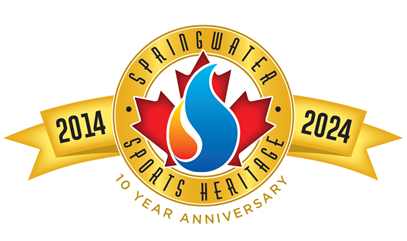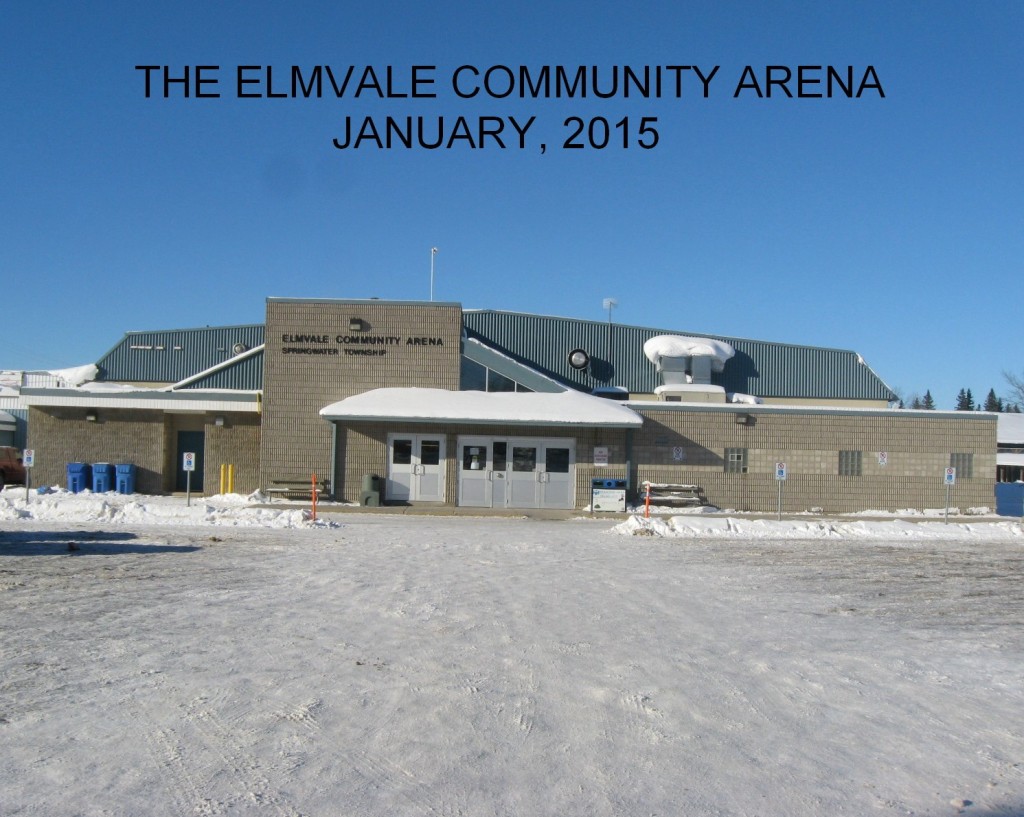 On November 6, 1947, The Elmvale Lance reported that a group of representatives from interested organizations met to discuss plans for building a new enclosed rink. They wanted this structure to be built on the Agricultural Grounds in Elmvale.
On November 6, 1947, The Elmvale Lance reported that a group of representatives from interested organizations met to discuss plans for building a new enclosed rink. They wanted this structure to be built on the Agricultural Grounds in Elmvale.
The meeting was held on October 30, 1947 in the Board of Trade Room and members were enthusiastic, discussing costs and times of possible construction. Representatives of municipal councils in Elmvale, Flos, Tiny, Wasaga, Medonte and Vespra all took part in this planning. Many Curlers, Hockey Coaches, Farmers and members of The Board of Trade, Agricultural Society and Women’s Institutes, endorsed the formation of a new Planning Executive.
There was no mention of a Lions Club as they hadn’t yet been formed. Perhaps this project may have been the impetus for quickly organizing the Lions Club as they took charge and got the rink construction going in 1950!
The following article was written by Jerry Chapple, an Elmvale Lion Charter Member who worked for The Elmvale Lumber Mill and who was involved in the building of the Arena as a volunteer.
This article was printed in the Elmvale Lance sometime in the mid or late 1960s .
OUR FIRST ARENA WAS A MODEL OF COOPERATION
By Jerry Chapple
The original conception was inspired by the early members of the Elmvale District Lions Club and heartily endorsed by its expanded membership.
The whole thing was a fantastic example of community cooperation. Agreement by The Flos Agricultural Society to allow the use of their fair ground. The support of the Flos Township council which was given in unstinted measure, and too, the Village of Elmvale council, who, were up to their necks in the other Elmvale project which was underway at the time, namely that of the restoration of the Community Hall.
We remember the decision of the Flos Council to donate trees along the Township roads that were large enough to cut for logs and how with many back breaking hours of labour with axe and crosscut saw (no chain saws those days),the trees were felled. We remember with nostalgic pride the sunny day in March 1950 when the long line of 19 teams drew the logs to Copelands mill for machining into the lumber that subsequently was used for the cement forms and back boards. The Copeland Family never did get around to sending a bill to the Arena committee, but that was typical throughout the district. We remember Elmvale Planing Mills donating the use of their cement block making machine during the evenings and some of its staff and many local men worked six evenings a week to make at least half of the large number of blocks required. Enough of the local blocks were laid that fall to provide a natural ice surface and in the summer of 1950 the balance of the blocks were purchased to complete the erection of the walls.
While this was going on many people were participating in one of two door to door canvasses to provide the necessary financial assistance. Young people, yes and older people too, were busy staging variety and stage shows to raise further funds.(Very good shows they were, too).
On February 19, 1951, the very welcome letter from the Department of Agriculture notifying us that the first of two cheques for $2500.00 would be presented in March 1951.
Looking back, acknowledgement should be given to the former editor publisher of The Lance, Alec McAuley, for providing a great deal of space in the Lance for Lion and Arena affairs, much of which was not provided until almost going to press time. The Lance actually served as liaison officer for the district, enabling people to keep in touch with progress of the Arena. It was utilized too for publication of lists of donations and names of voluntary helpers who gave freely of their time, yes, and money too.
Many things are pleasant memories. One of these was the draw for a registered Ayrshire heifer calf, donated by Howard Ritchie (who is still a Lion).Oh yes, the winner of that draw gave it back to the Lions Club, it was put up for auction and guess who bought it back? Why, Howard,of course.
Reg Bertram and his family should be mentioned for their devoted and unflagging energy in providing help and leadership. To Ross Bertram for his truss design and his supervision, but then so many people helped and gave all they could give. We remember the weeks of search for sufficient steel plate for the truss plates, and then the picture in the Lance on February 4,1952 showing the happy faces of the Arena Committee watching the second arena truss being raised and positioned by means of a central gin pole. We remember too, the many days of cheerfully donated labour mixing concrete for the footings and the concrete pilons , and even the mixers were borrowed.
Shortly after the roof was put on temporary dressing rooms and a refreshment booth were built. (The booth served them well for eight years, again voluntary help.)
By 1960 the Arena was equipped with washrooms and by 1963 the artificial ice making plant was in operation.
Many incidents have come to mind, as we write this, but in general the overall impression of the kindness, generosity and all round willingness of those asked to help have stayed with us over the years, and looking back down those years, we, on behalf of those that (at that time) committed to you to that tremendous project, say thank you and well done.
A FURTHER STORY OF THE ELMVALE ARENA BEYOND 1950
Written for the Springwater Sports Heritage Website
By Frank Archer, January 2015
I spent a lot of my life in and around the Elmvale Arena as my kids and grandchildren grew up. When I became a board member of The Springwater Sports Hall of Fame, I realized how important it was that we create a way to put our sports’ stories on a website for the future.
I also realized there were only a few of the people around that were still able tell stories of the arena creation. I contacted Jack Dyer, Paul and Don Bertram and visited The Simcoe County Archives to find information. Jack had a copy of Jerry Chapple’s article so we even learned more of the colourful details such as selling tickets on a heifer. Alex Currie and Dick Columbus have also been helpful in adding information.
It appears that the first Lions Club had Frank Roberts as president and they decided to build the arena starting in 1950.A planning Executive from 1947 had done the preliminary paperwork. However, the land belonged to the Agricultural Society. In June of 1951, the land for the arena site was deeded to Flos Township. I don’t know details of why but I assume insurance coverage would be important in case of injury as the arena building progressed. When the motion was made to change the deed, Walter Middleton of council, Joe Dyer of the Lions Club, John Lambie of the Agricultural Society and Fred Morrisey, a business man were all present at the meeting.
The Lions organized quickly, hiring a contractor, Ross Bertram, and local men gave of their time to make the blocks at the old Planing Mill, which was located near the fairgrounds at 40 Peter Street ,Elmvale. Any money required for materials had to be raised so all labour and tools and machinery were mostly donations or loans. Several cement mixer machines were used ,as volunteer labour shovelled gravel and cement, then poured it for foundations and pilasters needed to hold trusses. In 1951, the walls went up, as local help laid blocks ,day after day, between pilasters.Alvin Simpson,a local mechanic,cut up old car frames with his torch to act as rebar to strengthen the pilasters.
Then came the trusses, built, one after another, on the ground or future ice area. They were positioned cornerwise while being constructed and were built of B.C. fir which was brought into town by rail on boxcars. Men used sledge hammers as they laminated those 2 x 4 x12 planks together with 6 inch spikes.
A diagram on the next page tries to show you how Alex Currie`s wrecker was used to winch up the cable using a 70 foot GIN POLE with double pulleys, one on top and one on the bottom of the gin pole and two attached to the truss. This made the pull 50% lighter than single pulleys would do. Each truss weighed about 15 ton so the pull would be 7.5 ton. 4 guy wires held the GIN POLE straight up with a tractor anchoring each Guy Wire, north, east, south and west. As the trusses had to be built inside,on the dirt floor, they could only build one at a time, then hoist it onto a pilaster , on each side of the arena. Currie`s wrecker was needed each day that a truss was built and ready for hoisting . Alex was in charge of the winch, as a slip of control endangered a lot of helpers who had to negotiate the turning and setting onto the pilasters. After every truss was erected and secured as to not lean, the moveable stoneboat,on which the Gin Pole was mounted, was unpinned, moved ahead 20 feet and spiked in again, ready for the next hoist. They averaged three trusses up every two weeks.
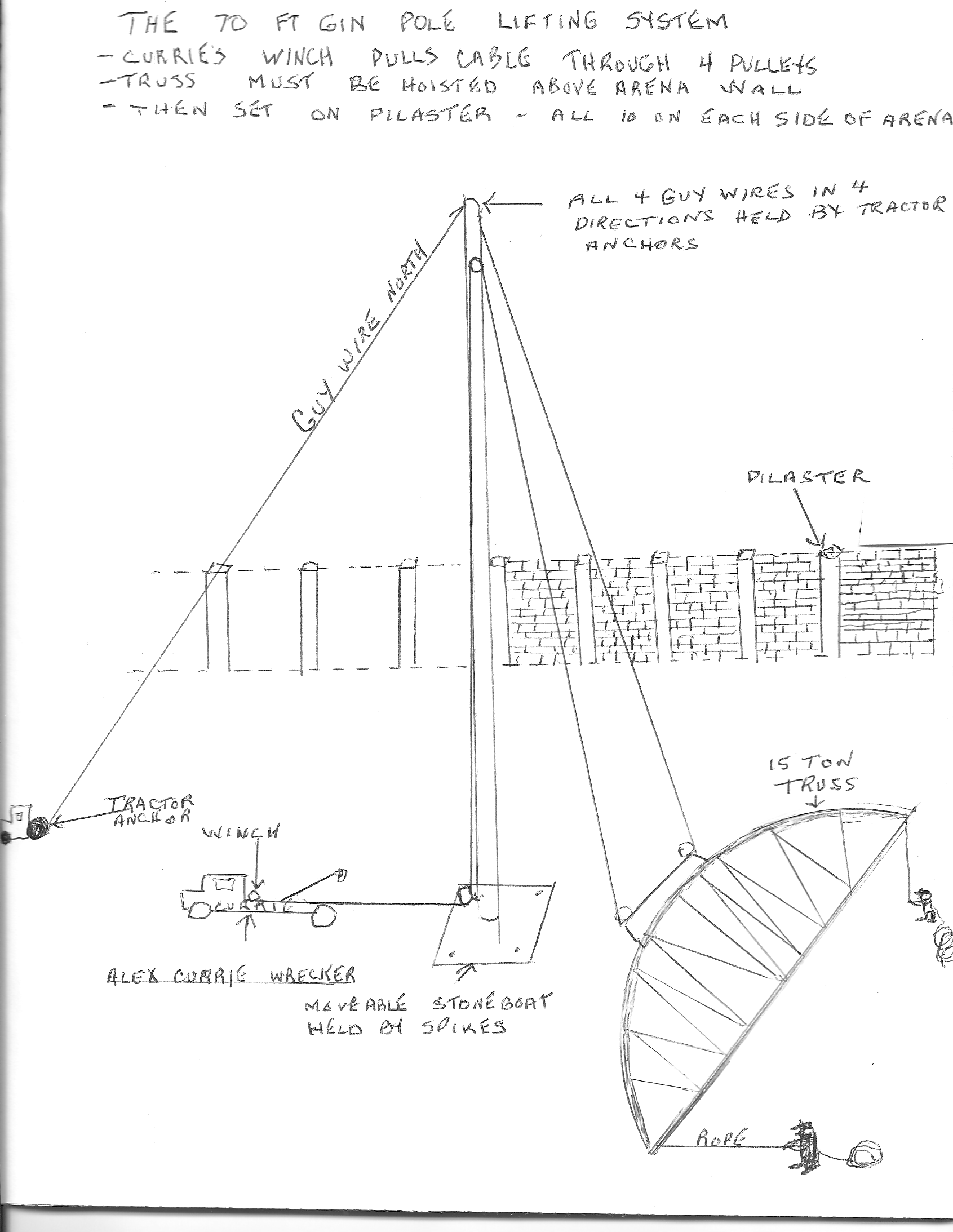

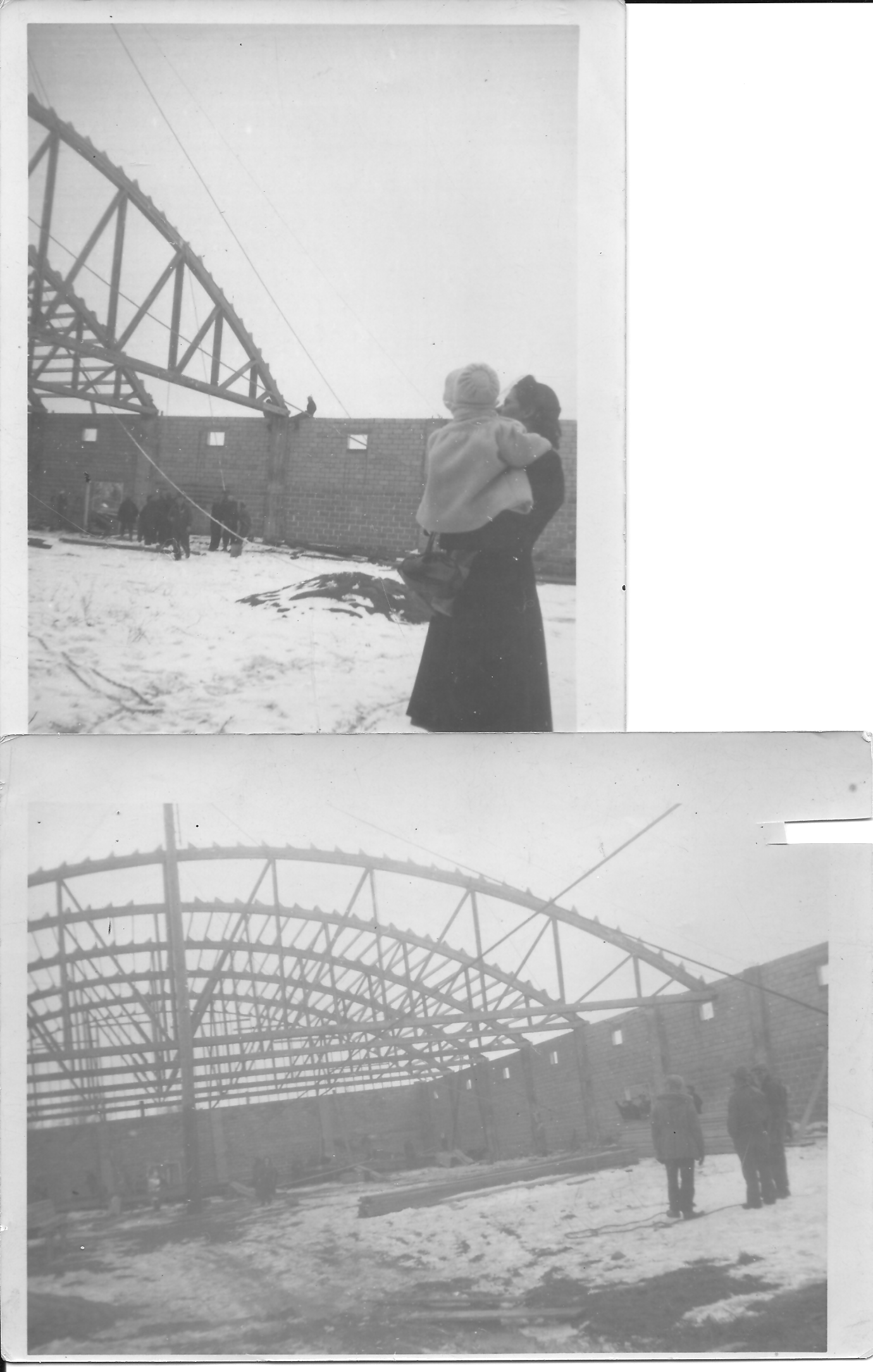
Alex donated his use of the wrecker, his expertise and time, as many others did, to get the massive project done. Alex also supplied the previous pictures which depict the different stages of the building and raising of the roof trusses.
Ross Bertram, the building supervisor, found the 70 foot Gin Pole. On it he bolted two pulleys, top and bottom through which they ran the cable. Then, Cec Townes and Hughie Burnett climbed the pole and fed the cables through all 4 pulleys. One end of the cable hooked to the winch on the wrecker and the other end through the 4 pulleys and back to the top of the Gin Pole. Cec has been recorded to say that he could see the boats racing at Orr Lake when he was at the top of the Gin Pole .70 feet up is very high when the wind is blowing! Cec, an electrician, and Hugh who worked for the local Flos telephone company, were experienced climbers.
After all the trusses were in place and secured, then came the miles of lumber for the rafters and sheeting to be nailed into place, most of it in the early winter months of 1952. Laidlaw Lumber supplied lumber for $2387.97.
The roof was built to hold a snowload of at least 50 pounds per square foot. Carmen Robinson was hired to put on 260 squares of shingles at $5 per square. The cost of the shingles was $1635.00. Now the volunteers could build some boards around the ice surface and some temporary dressing rooms. By January 1953 the ice was ready!
The Arena Governors asked The Lions to operate the arena. Rates were set for ice times as such: Minor Hockey practice….free ;
Teams with players over 16 years of age pay $4 per hour;
Skating … Tues. and Thur. night and Sat. P.M. at 20 cents
Whole evening…..18 dollars
Games…charge admission but 60% to Arena, 40% to team
The arena managers pay was 50% of the receipts.
(Reg Bertram was the first arena manager in the new building.)
There were so many individuals, men and women, who gave freely of their time, money, and actual labour. Also, several fundraisers worked tirelessly, seeking donations, selling tickets and organizing events to raise money.Can you imagine going door to door,hoping to raise $50,000 in 1950.
In 1950 you could buy a new car for $2000 .A beginning teacher in Flos would be paid $1800.Using these prices,I guess $4 per hour for ice time was fair.Today{2015}ice time is about $100 per hour
In May of 1956, George Graham and Harry Rowley met with the Board of Governors to ask for permission for The Curling Club to add a 3 sided addition to the arena on the West side. Three days later, that permission was given. The Fair Board was to have the use of the Curling Rink for the annual Fair.
In October 1958, direction was given for George Graham and Reg Bertram to be in charge of building new washrooms and dressing rooms in the arena. In 1959, a new furnace was bought and installed for dressing room heat.
It was written that the Lions and the Arena Govenors would share deficits of operation on a 60/40 split until 1961 and then in 1961-62 the Lions paid a $900.00 share. In 1963, the Lions bowed out of a set percentage. Then, an Arena Committee of three men was appointed to operate…..Dr. Patchell, Ken Knox and Frank Archer. .
Minor Hockey was not organized into leagues as you couldn’t be sure if you had ice or not and, a thaw would disrupt any kind of league organization. A plan was needed to install artificial ice. It started at the grass roots of parents and coaches forming an Artificial Ice Committee.
The committee organized to fundraise. There was no government money that we knew of. Every cent was being raised by ticket draws or donations. The Elmvale Legion organized a major 50-50 draw with a $100 winner every Friday Night. Canvassers flooded the township of Flos and Elmvale and donations were as high as $100. Most donations, however, were between $2 and $20.This canvassing went on from June to December, 1963.
We had done a lot of planning as to what had to be done immediately so
we hired Bernie Pilon to dig out 6 feet of dirt. Then, volunteers laid draining tile in 8 parallel rows, 10 feet apart, from one end of the arena to the other. This was all connected and all water would flow through a new drain to the north east to Lorne Street.
Then, gravel had to be hauled from township pits to fill the hole five feet deep. On that was 6 inches of sand. Crossrows of 6×6 posts, end to end, were sunk to hold brackets on which were laid pipes for the brine. There were about 140 rows of pipe, 6 inches apart from one end of the rink to the other. At the north end, the pipe was fed from a Header Pipe every three feet across and this Header joined into the freezer compressor. A new cement room was built to house the compressor and circulating pump. Of course this was costly with expensive hydro installation to drive the giant motors.
Just in time for Christmas, the ice plant was ready but snow had to be laid on the sand around the pipe and packed by tramping gently.
Freeman Bumstead loaned his tractor to haul snow to the front door and after school, kids with toboggans hauled it in to place on the sand and pipes (very carefully).By 10 p.m., it was ready for the plant to turn on. Workers sprayed water to freeze, layer on layer, all night long. The next day there was ice BUT there were about 10 holes throughout where brine, under pressure to push it through, was leaking up through the ice. HUMBUG!
All the contractors’ men were on holidays, so the ice plant was turned off and in January those welders had to come again to reweld some pipes. This meant that all the ice had to be made again! All the snow had to be brought in again! Finally, we had ice and hockey and skating finally got started in 1964.
We didn’t want that to happen again so a new terrazo-like floor was proposed. We had to raise $3500.00 dollars for the new floor and, that summer, it was installed so that the snow hauling was no longer needed. Ice could be made whenever you wished. Dr.Patchell, Earl Elliot and Ken Knox were on the committee to raise the money. Again, The Lions Club helped by donating $2000.00. More money was sought from donors. Board minutes of June 17, 1964 show that the new floor cost council only $158.42.
This floor was of a quality that would withstand roller skating. We held a huge walkathon and raised enough money to buy roller skates and shelving. This program started the next summer and ran for several more summers.
Next fall the ice was made right after the Fair. Ice was scraped by players pushing shovels, round and round the rink, after each game.
Very few people know that Ludwig Lahnsteiner, with help from Howard Heacock, built a tractor scraper and spent countless hours after the skaters were gone trying to get it to work properly. He would bring the tractor scraper from his garage to the arena about 11 p.m. but couldn’t get it to scrape properly.
Finally, Ludwig gave up as the ice was going out. It was April! The Arena Committee then bought a tractor and scraper in Paris, Ontario.
Minor Hockey was growing into more teams and bigger leagues. John L. Coe was a force in getting team sponsors. He sought enough money to build a drying room for sweaters and with volunteer carpenters and masons, built that room free of cost to the arena. It is now the referees’ room.
Elmvale was regarded as a great active hockey town and families who love hockey wanted to move to this area. You could live in a 10 mile radius of Elmvale and qualify to play OMHA HOCKEY.
Figure Skating too, was getting more enrolment. Our skating stars were shining. Recreational hockey leagues, too, kept the arena open late into the night. All went relatively smoothly until March 1975, when a tractor, being refuelled caught on fire. The fire spread to the roof, shutting down the building for over a year. It cost well over $150,000.00 as new trusses and a steel roof were a necessary part of the rebuilding. (See the following pictures of the arena that were taken after the 1975 fire.)
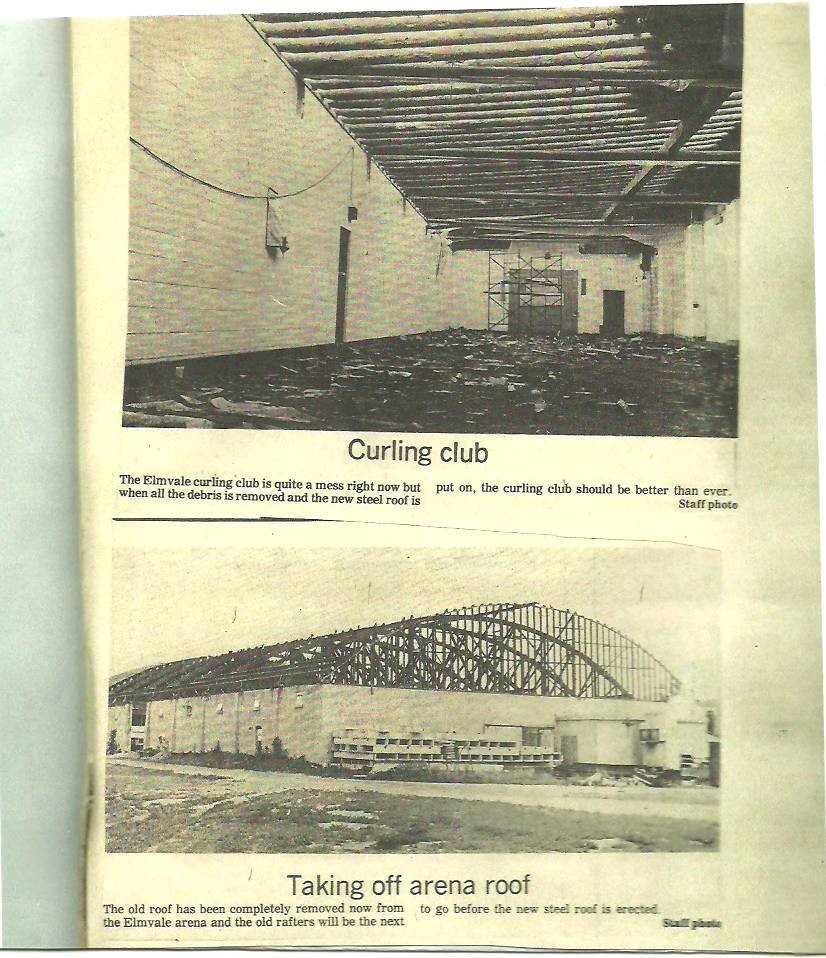
AFTER THE ELMVALE ARENA FIRE IN 1975
John L Coe brought a proposal to The Arena Board that was accepted in 1976. It was to buy concrete seating taken out of the Old Barrie Arena and have it installed in the Elmvale Arena. The cost was $28,000 and John L was instrumental in collecting the $28,000 to pay for it. Percy Frankcom supervised the whole seating project and installation of new boards around the ice surface. Rounder corners were made for safety. All of this was labour intensive and volunteers were sought to help. Now they were ready for the Fair! (The Fair had to be cancelled in 1975)
Money was always scarce. Arena maintenance and energy was and is costly. New sewers were installed at a high cost. The Board of Governors felt that costs needed to be spread out over all the surrounding municipalities in a fairer way. Each municipality, including Tiny and Vespra, Flos and Elmvale plus, the Lions Club, Minor Hockey and Figure Skating all had representatives appointed. Also, there were four other groups to total 11 that were making decisions and determining who pays what and when.
The new Governors, in 1977 decided to build a new front entrance at an approximate cost of $9,000.00. In 1978, about $20,000.00 was spent on upgrades to the tractor room, dressing rooms, ice surface boards and corners, the replacement of the compressor and the pouring of a cement slab on the east side of the arena to avoid roof splash washouts. The arena was in good shape now.
In 1993, Government Safety Inspectors deemed the roof unsafe for the snowload and a major rebuild was required. George Allen and Gloria Woods headed up the fundraising committee and raised the required $560,000.00. The Ontario Government provided the other half. More dressing rooms were added as well as office space, an elevator and more.
It is interesting that this rebuilding project coincided with the inauguration of Springwater Township in 1994.The operation of the arena was now included in Springwater Parks and Recreation responsibilities and remains as such.
I hope this article is useful to those who might have wondered how and when the Elmvale Arena Got Built.At least,this my understanding of it.
